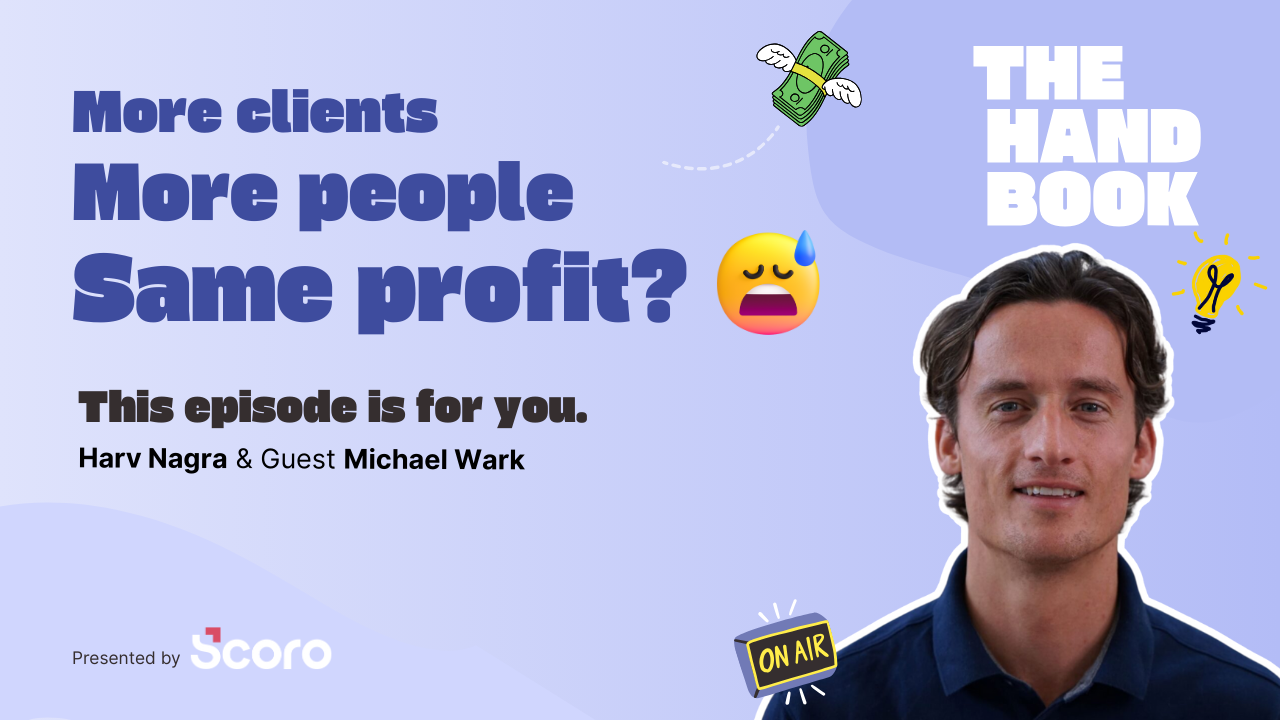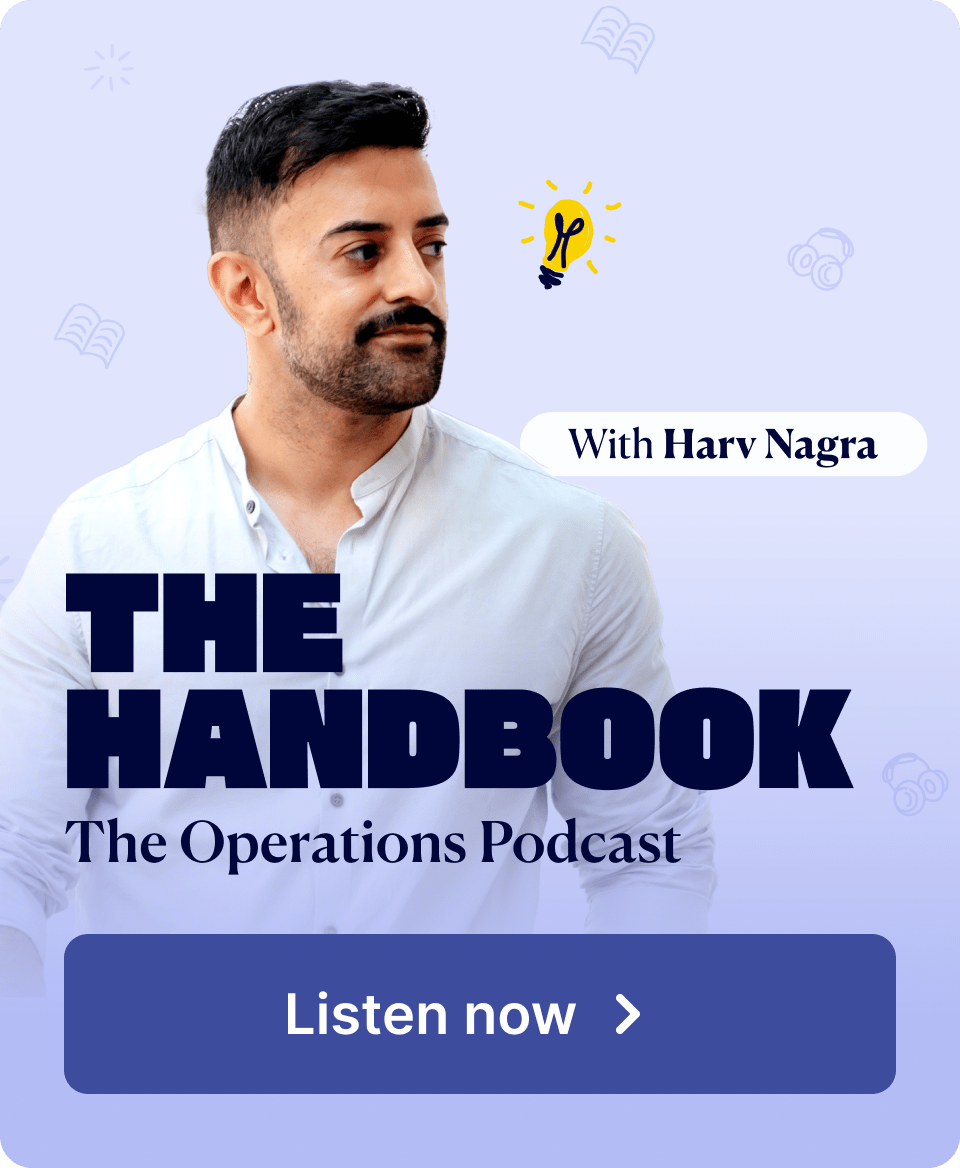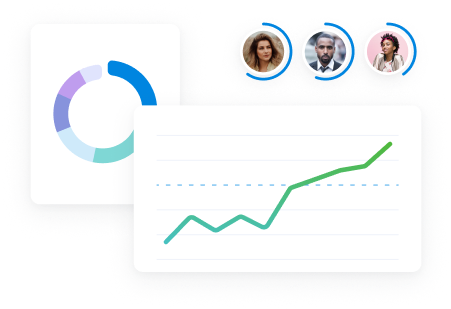Building off a founder’s network and relying on inbound sales can help your agency grow at the start. But it’s not a sustainable long-term approach.
We talked to Friday Solved founder Ryan Hall about his approach to scaling sales.
With over 23 years of agency experience, including two successful exits, Ryan knows how to sell.
Here are his insights and tips to improve each of your funnel stages for the long run.
What a scalable sales engine looks like
A scalable sales engine has a sales funnel with different parts that are clearly owned, optimized, and iterated on regularly.
This is different from the common agency approach of having one person manage end-to-end sales.
As Ryan explains,
Having someone who has to manage the top of funnel, mid-funnel, and all the way to close is a fundamental no-no for me. You’re trying to hire a unicorn—what you need is the right people in the right place.
Each core funnel stage—top of the funnel, middle of the funnel, and bottom of the funnel—should have separate “owners” with unique skillsets and goals:
| Funnel stage | Main goal | Skills needed | Responsible roles |
|---|---|---|---|
| Top of funnel (TOFU) | Build awareness and generate leads | Process building, testing and optimizing outreach, marketing execution | Business Development Rep (BDR), Marketer, Founder, Sales “Driver” |
| Middle of funnel (MOFU) | Qualify and convert leads into opportunities | Trust-building, discovery frameworks, patience, persistence | Business Development Manager (BDM), Account Manager (AM), Account Executive (AE) |
| Bottom of funnel (BOFU) | Close deals with confidence | Interpersonal communication, negotiation, objection handling | Senior AE, Founder, Dedicated Closer |
You don’t necessarily need a full-time person in each role if you’re a small team. But you do need clarity and ownership of each stage assigned to someone within your team.
Otherwise, things will inevitably fall through the cracks.
Say your account managers or business development managers are forced to juggle lead gen, account nurturing, outbound, proposals, and closing.
Their focus gets scattered and they start to lose control over different areas. Which leads to unpredictable, chaotic, or slow sales.
Compare that with having clear owners for each stage of the funnel.
Each person can dedicate clear time and attention to the work that drives the stage forward—and can do it repeatedly and consistently to scale.
As Ryan puts it:
“With the right people in the right place, that’s where you get a sales process that becomes really interesting, really scalable, and really resilient.
How to improve each funnel stage (with examples)
Sales isn’t a one-size-fits-all process.
Instead, you need different tactics for each stage of the funnel.
With distinct processes, tools, actions, you can optimize each part of the funnel. And make real sales progress.
1. Top of funnel: Create motion
The TOFU stage requires cold outbound—generating interest, awareness, and leads from people who don’t know your brand yet.
Too many agencies either ignore this stage (assuming qualified leads will find them through referrals, the founder network, or some other means), or they don’t do it consistently enough to generate results.
Instead, Ryan says, you need three things for effective TOFU outreach:
- Channel focus: A narrow and defined channel outreach strategy that can be scaled and optimized
- The right tools and technology: A way to get data on prospects and leads in a simple and effective way.
- The right processes and strategy in place: To hypothesize about what works, test it, and optimize your outreach.
Together, these areas create a consistent “rhythm” that generates consistent, forward motion. Which you need to grow your brand awareness and conversions.
Here’s how to do optimize them:
Channel focus
The best TOFU channels are ones you can control and scale. Ryan recommends starting with just two: LinkedIn and outbound email.
These channels let you directly drive activity, connect with potential prospects, and test messaging—all things you can manage and scale while getting in front of your ideal customer base.
But, as Ryan explains, each channel needs its own strategy:
LinkedIn has to be a much softer, slower burn; email can be a faster, hotter burn. But again, you’re thinking with the process of, ‘We’re going to test a hypothesis … and just look for gains every month as you iterate on that.
LinkedIn:
- Start a weekly LinkedIn post series from your founder sharing short insights, client wins, or lessons from recent projects
- Start conversations with commenters or people in your extended network asking for feedback or discussing broader industry ideas
- Follow up your LinkedIn strategy with cold email outreach (tips below)
This post from Brooklin Nash, is a great example of the kind of founder-led content that works well on LinkedIn.
Sharing real lessons from client work, setting expectations, and showing thought leadership without being salesy.
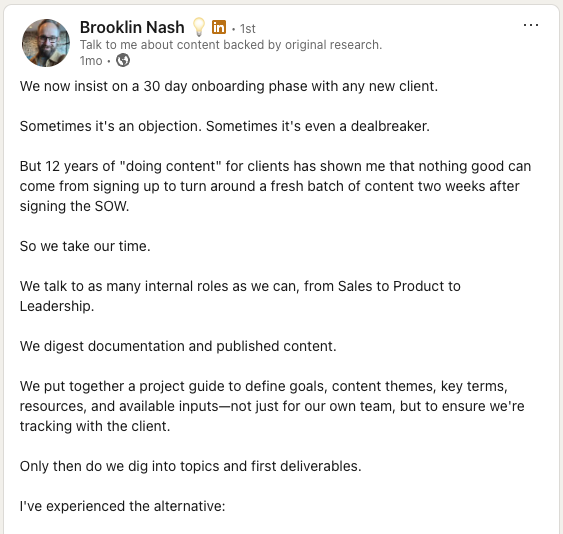
Don’t know where to start with your LinkedIn strategy?
A LinkedIn course, like this one by Justin Welsh, can give you the exact tools, playbooks, and strategies needed to get started effectively.
It’s not just “post more, engage more.” It gives you a clear framework for figuring out your niche, creating content that people actually want to read, and turning that into leads (without feeling like you’re pitching all the time).
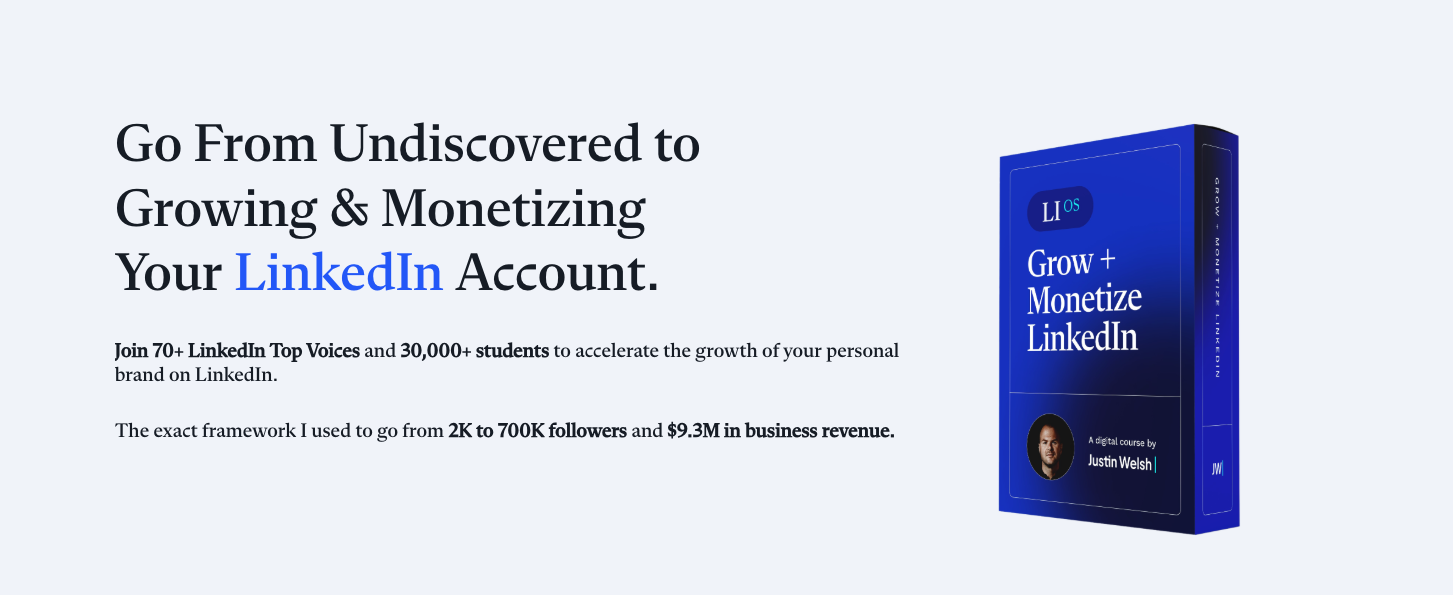
Cold email:
- Use a tool like ListKit or Smartlead to follow up with LinkedIn contacts
- Keep your messaging “targeted, relevant, and human”
- Focus on starting conversations, not booking sales calls
- Ask questions and use industry data or case study insights as starting points for meaningful discussions
The golden rule? Write emails you’d want to reply to.
Need a guide to cold emailing?
Check out Apollo’s seven-step process or their 40-minute master class to learn how to write standout cold emails every time.
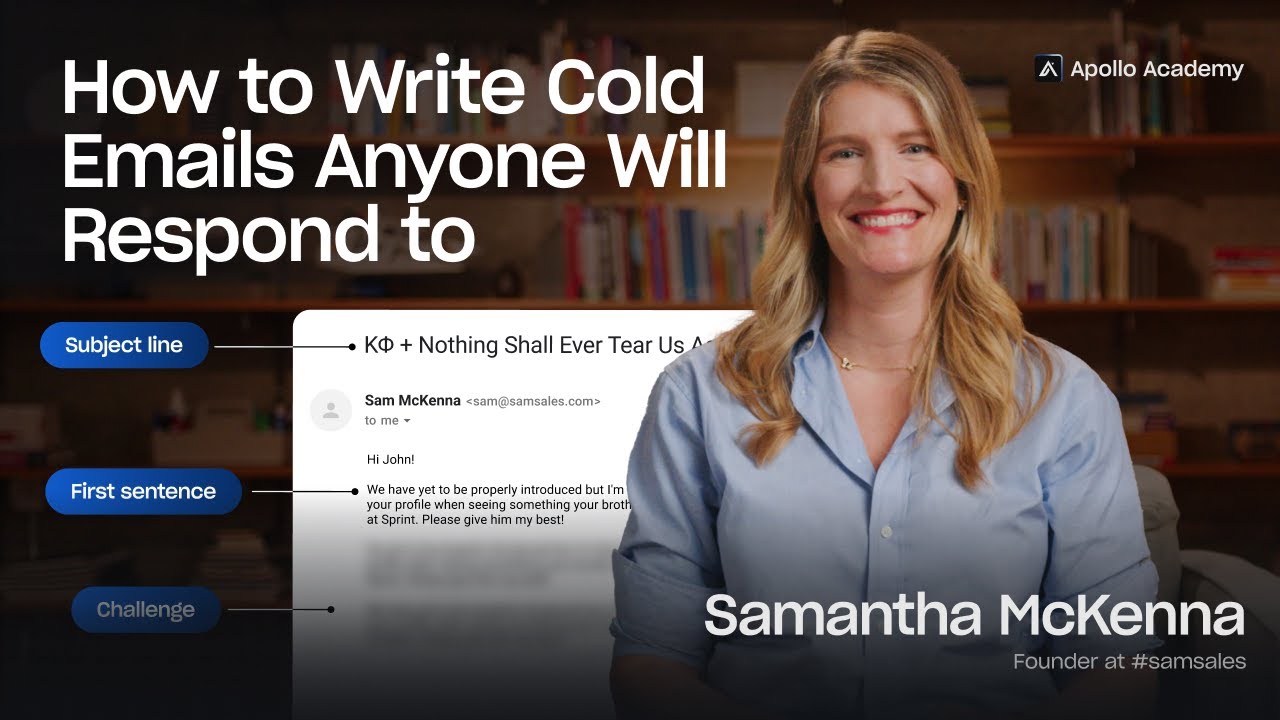
The right tools and technology
TOFU tools should automate what’s already working while helping your team stay organized, test new hypotheses, and move faster.
Here’s the tech stack Ryan recommends:
- LinkedIn Sales Navigator: It’s not a great tool for filtering lists, but it’s necessary for sourcing data
- Meet Alfred: For automating LinkedIn messaging flows
Email prospecting
- ListKit: Ryan prefers ListKit to Apollo for more accurate data and better deliverability.
- Smartlead: A tool for automating email outreach flows that can integrate with ListKit
CRM and motion tracking
For beginners, Ryan recommends Hubspot.
Use it for content management, tagging leads, logging activity, managing sales stages and your pipeline, and automating some follow-ups.
He emphasizes that, while it’s a great starter platform, it’s hard to scale with it:
HubSpot is a great tool but… I’ve got a slight love/hate relationship with it… It gets expensive quickly.
Enter a professional services automation (PSA) tool like Scoro.
In addition to control over your sales pipeline, you’ll gain control over everything from invoices and reporting to projects—all in one spot.
This kind of tool is best for growing teams and agencies who are ready to systemize all their operations and create a single source of truth.
And if you get started in Hubspot and later move to Scoro, you can use the Hubspot integration to move or connect all your data into Scoro. No manual copy-pasting needed.
Processes and KPIs
In the TOFU stage, processes and KPIs should center more on output than outcomes.
As Ryan explains, TOFU is all about consistent action. It’s the foundation of sales progress.
So your driver who “owns” TOFU needs clear, repeatable steps and goals designed to keep momentum.
For example, a junior marketer could own outbound via Sendlist, sending 50 targeted emails each week with A/B testing and reply tracking.
Meanwhile, the founder posts on LinkedIn twice weekly and actively engages with comments to spark conversations.
Other “motion metrics” could include:
- 100 outbound emails per month
- 10 new LinkedIn connections per day
- Five discovery calls booked per month
These kinds of KPIs help you build your pipeline through volume and consistency. Don’t worry about conversions yet—that comes later.
2. Middle of funnel: Diagnose, don’t pitch
The middle of the funnel (MOFU) is usually where good leads fizzle into forgotten columns in your CRM.
Discovery gets rushed, nurturing happens inconsistently (or not at all), and there’s no solid criteria for qualifying prospects.
Suddenly, you’re drowning in overlooked leads, generic proposals, and bad-fit clients.
The result?
A sales pipeline that stalls and generates inconsistent revenue.
To fix this, Ryan recommends three “Ps” for MOFU optimization:
- Make a process
- Match their pace
- Above all, be patient
Make a process: Discovery > pitching
Sales is not about hunting for briefs. Sales is about hunting for problems.
Discovery calls should be less about outright pitching and more about uncovering deeper prospect needs.
This way, you can better understand their unique pain points and buying triggers.
And use that knowledge to present tailored solutions—ones that make conversions more likely.
Use a clear framework for discovery calls that make it easy to “diagnose” client issues.
You can come up with your own templates. Or use one of these two popular frameworks:
| Framework | Stands for | Best used when | Strengths |
|---|---|---|---|
| BANT | Budget, Authority, Need, Timing | You’re qualifying leads quickly in short, simple sales cycles | Fast, simple, easy to train on |
| MEDDIC | Metrics, Economic Buyer, Decision Criteria, Decision Process, Identify Pain, Champion | You’re selling complex solutions to multiple stakeholders | Deeper insights, better for consultative selling |
Whatever approach you choose, the goal is to have a conversation that reveals exactly what prospects need and who’s involved in their decision making.
Match their pace: Meet leads where they’re at
Ryan recommends thinking about sales as a user experience journey.
That is, think about all the steps and stages someone will go through as an outbound or inbound lead.
Unlike outbound, where all leads are more or less “cold,” MOFU has a mix of leads with varied “journeys.”
Some are warmer inbound (who already know and maybe trust your agency), while others came from cold outreach (who need more nurturing to get to the same level as the inbound leads).
The best approach?
Match your nurture cadence to their level of engagement—faster if they’re expressing clear interest, slower if they go quiet.
Once you qualify how “warm” they are when they reach the MOFU stage, you can map out the processes, micro-nudges, follow-ups, and other “touches” you’ll need to nurture any lead from awareness to close.
The prospect isn’t receiving the customer experience when they buy from you, they’re receiving the customer experience from the first time you try to reach out to them.
Use email and CRM tools like the ones we shared earlier to:
- Track leads and pipeline status
- Send automated follow-ups based on timelines, triggers, or engagement
This way, you stay on top of every lead and match their interest with a targeted workflow.
Be patient: Stay organized and keep communicating
A clean, well-structured CRM drives sales momentum, accountability, and confident forecasting. And it makes MOFU easier and more effective.
Avoid vague pipeline labels like “maybe,” “waiting,” or “following-up.” Instead, create clear stages with defined criteria for each one.
For example:
- Discovery: We’ve had a call and identified potential fit
- Qualified: They meet basic BANT/MEDDIC criteria and want a proposal
- Proposal Sent: Pricing and options have been shared
- Verbal Commit: They’ve agreed verbally — paperwork pending
- Closed Won/Lost: Deal is signed, or it’s over
This way, everyone stays on the same page. And owners know what they need to do (and when) to keep leads engaged and prevent them from stalling out.
When it comes to choosing stages, get granular. Ryan notes that more pipeline stages tend to make it easier to track deal progress and tailor follow-ups.
Case in point: One of Ryan’s sales funnels includes 22 stages!
Enter your unique pipeline phases in Scoro and track progress through them in the “Pipeline” view.
Here, you can quickly see the total number of quotes, where they are in the process, and who owns them. For more details on each quote, just click on the quote card.
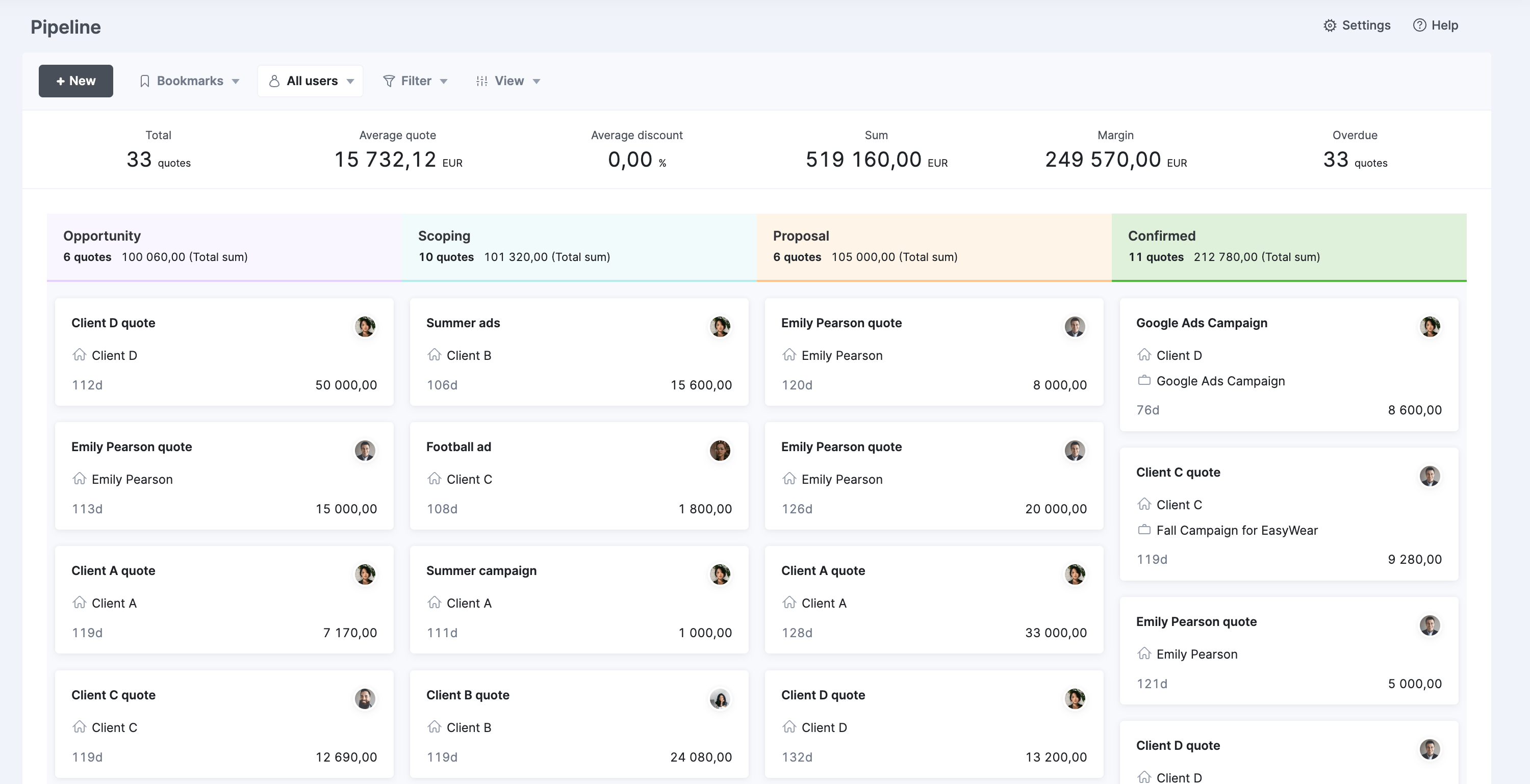
To make sure nothing falls through the cracks, use “View” filters to add “Overall age” and “Days in status” to your quotes.
This will help you easily identify prospects that have been stuck in a given stage for too long and help you pinpoint who to follow up with.
You can even integrate your Hubspot data with Scoro—and match your Hubspot deal pipeline to Scoro statuses.
So whether you send a proposal or qualify a lead, all your data is automatically updated.
Use your CRM insights to guide your communication cadence. Don’t stop following up (unless the prospect directly asks you to).
Ryan emphasizes that patience and persistence are the keys to MOFU nurturing:
Patience is often a real stumbling block when it comes to middle of the funnel nurture. We have this idea like, ‘Well they came to us and now they’ve gone cold on us, they must not want to do it anymore.’ Well, no. … Just because they’re not replying to you doesn’t mean they aren’t interested anymore — they’re probably just busy.
Like TOFU emails, a good MOFU follow up should add value and foster connection.
The key difference:
Where TOFU emails are trying to spark something new, MOFU emails should build on whatever common ground and connection you’ve already developed.
That is:
- Add value, not pressure: Every touchpoint should give something valuable. Think about continuing a conversation, not just “checking in.” Share new insights, ask for feedback, or pass along a relevant resource to go deeper.
- Avoid repetition: Vary up your follow-up format and channels. Try LinkedIn, voice notes, or even a quick video.
- Meets the lead where they are: Understand their pain points, interests, buyer triggers, and real needs to offer the most valuable resources. “Sales content” and pitching aren’t off the table, just be aware of the lead’s readiness to buy. Most of all, keep it personalized—don’t just use a template.
Not sure what to say?
Check out these follow-up resources for a guideline:
3. Bottom of funnel: Clarity beats pressure
It’s easy to lose traction right at the finish line.
The pressure to win deals can actually cost you them—resulting in overly complex proposals, overthinking objections, and inconsistent follow-up.
Ryan’s advice? Keep it simple.
Focus on clear, targeted proposals and straightforward answers for client questions. Send thoughtful emails after meetings. And make sure every deal has a dedicated closer.
Simplify proposals
A 40-page slide deck isn’t “covering all your bases”—it’s losing your audience.
A great proposal helps you and your client align on the problem, the path, and the clear outcomes at the end.
In another podcast episode, Freia Muehlenbein, Be Reyt growth consultant and agency leader, shared this process to pitching and proposals:
- Run a “war room” strategy session: Bring key stakeholders together to align on goals, KPIs, and key outcomes for a stronger pitch
- Focus on value and ROI: Spend less time in your proposal talking about you and more time talking about the results the client will get
- Don’t forget the post-pitch follow-up: Leave time for questions, if pitching live, and send a follow-up email after to make sure everyone has what they need
Want to strengthen your pitching skills? Watch Freia’s entire episode or get the recap.
Handle objections confidently
Handling objections can feel like fire-fighting. A client jumps in with an objection, and you have to think on your feet to refute it.
But most objections are predictable—they’re about budget, timing, or trust. So instead of trying to handle them on the spot, build an “objection vault.”
An objection vault can be a shared internal doc that lists the top objections from prospects, suggested responses, and any social proof you want to include from past clients. Update it regularly with real examples from your team.
Common objections to prep for:
- “This is more expensive than we expected.” → Show a cost breakdown or ROI projection
- “We’re not ready yet.” → Revisit urgency and share a slower phased approach
- “We need to talk internally first.” → Offer a tailored summary deck for their team
Beyond those, look over the past six to 12 months of lost quotes or proposals and see what objections were deal breakers. Address those ones first with your team.
Follow-up consistently
A strong proposal can go cold if you don’t continue to nurture those leads.
Freia suggests sending an email within 24 hours after a proposal to:
- Thank the team for their time
- Reinforce key ROI projections and other benefits
- Address any questions that you couldn’t immediately answer
- Propose a timeline for checking in again
- Highlights any relevant deadlines for business outcomes or client timelines (i.e. “To launch by July, we’ll need to kick off by mid-May.”)
Make sure to tailor your follow-ups for different roles. For example, you could send a dedicated one-pager to the CEO with key benefits and ROI, and a more tactical recap for the creative team. That way, everyone has what they need to move forward.
Ownership and optimization
Your dedicated BOFU closer should have clear KPIs. This provides clarity and consistency. And also helps you track what’s working and what’s not. As Ryan says, “Optimize, optimize, optimize.”
Unlike TOFU metrics, BOFU KPIs should focus more on outcomes, not output.
For example:
- Proposal to close conversion rate
- Average deal closing time
- Number of follow-ups per deal
- Win/loss ratio
Use Scoro’s “Sales” dashboard to track these metrics in real time.
Here, you’ll see core agency sales metrics like pipeline, revenue vs. targets, and quotes per team member.
To add more, click the “Add to Dashboard” button to select different KPIs.
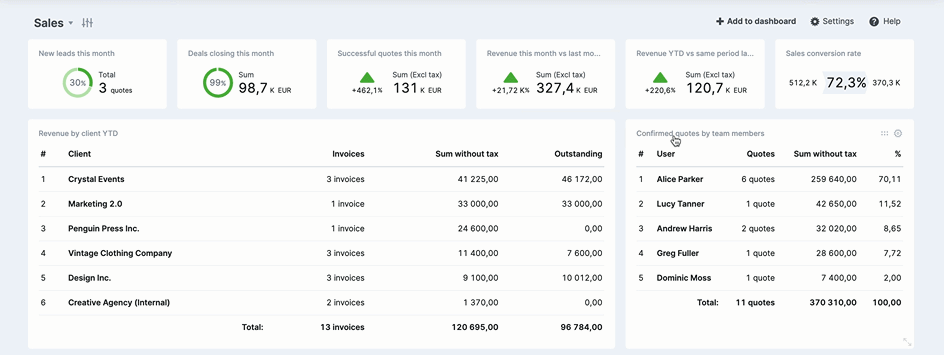
System first, people second
Scaling sales isn’t about hiring better salespeople. You scale by building a better system. Then, you hire people who fit that system and amplify it.
In short: system first, people second.
For help building that system, reach out to Ryan’s sales consultancy, Friday Solved. Or check out his latest book, “Don’t Sell.”
Then, see how PSA software like Scoro can help you implement funnel stages, processes, and tracking to optimize each step of your sales system.
For more agency tips and tricks, check out these other podcast episodes of “The Handbook:”
- “The Ops Cheat Code” with Harv Nagra
- “How to Pitch to Win” with Freia Muehlenbein
- “Growth Thresholds and Growing Pains” with Marcel Petitpas


